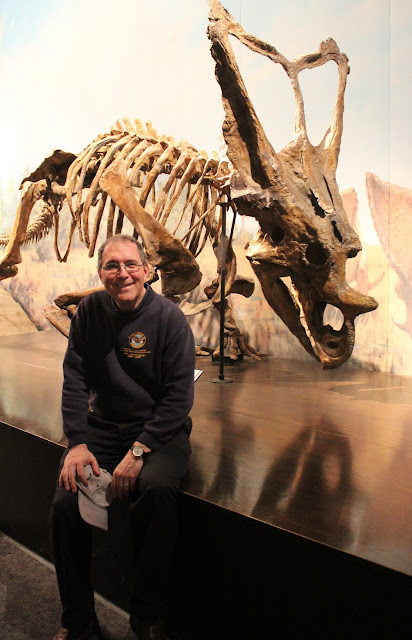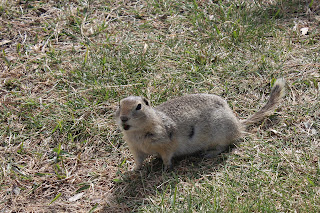We awoke to discover a layer of soft snow covering the surrounding woods and mountains. Not ideal for a Corvette with high-performance summer tires but after having a wake-up coffee and checking out, we gingerly took the car out of the parking garage and heading downhill to Banff. The roads were clear and dry so no problem and soon we found ourselves in the town proper.
With 8,000 inhabitants it is about the same size as Jasper, enjoying the same laid-back Western ski town atmosphere, but seemed more substantial. The commercial centre was much larger and it was easy to find a place for breakfast. We settled on Melissa's Missteak, which opened in 1928 and was apparently one of THE places to have a hearty meal to start the day. I enjoyed an excellent omelette and a serving of oatmeal as we had not really eaten anything since our big buffet breakfast in Jasper the day before. It was a bustling place and fun to hear the waitstaff speaking as they were all, like our doorman the night before, Australians.
We did a bit of walking around looking at the shops but for a Saturday morning it was very quiet but then it was really an off-season--too cold for summer events, too warm for skiing. The Bow River, which runs through town, was not flowing quickly with Spring run-off. Well-fed, it was time to turn back to the parking lot behind the Banff Park Museum and get in the car for the next leg of our adventure.
 | ||||
| The Bow River, Banff, Alberta |
Following the Trans-Canada Highway, we rolled east through Canmore and Kananaskis as a slight blizzard enveloped us. We soon found ourselves circling around Calgary and then it was time to leave the Trans-Canada, heading northeast now and leaving the foothills behind for the flat prairie. Next stop under blue skies: the Badlands, Drumheller and the Royal Tyrrell Museum!
 |
| Dinosaur Central: the Royal Tyrrell Museum of Paleontology |
Joseph Tyrrell was a geologist who was working with the Geological Survey of Canada when he came across an unknown fossil skull in the Red Deer River Valley by accident in 1884, remains of a creature later identified as Albertosaurus. He went on to become the mine manager at the gold mine at Kirkland Lake, Ontario for many years, ending his days in Scarborough, Ontario, having established an apple orchard on the Rouge River in a location now occupied by the Toronto Zoo. His doctor had suggested that as young man he give up law and switch to outdoor work for his health; it evidently worked as he made it to 98 years of age when he passed on in 1957. The museum that honours him was opened in 1985, becoming "Royal" five years later.
Situated in the Badlands, it is the only paleontological museum in the world where you can go outside and dig up dinosaurs. It located in the middle of the Late Cretaceous Horseshoe Canyon Formation and has more than 130,000 fossils and holds specimens primarily from the Alberta Badlands, Dinosaur Provincial Park and Devil's Coulee Dinosaur Egg Site. So many fossils found in Alberta were making their way east to collections at places like Harvard, Yale and New York, it was felt that a museum to highlight Alberta's great fossil wealth should be located in the province itself.
The museum has a particularly good selection of therapod dinosaurs, including a truly spectacular Tyrannosaurus rex whose fossil remains have turned black through chemical reaction, and of course lots of Albertasauri, but I particularly liked the ceratopsians, the horned dinosaurs of the Cretaceous of which Triceratops
is the most famous. The Royal Tyrrell Museum has quite a range of
family members from this group, along with other notable species, such
as the armoured Stegosaurus, notable for having brains both in its head and tail.

 |
| Many old fossils can be seen in the museum |
Stegosaurus (150 million years old!)
There is not a great deal else to see in Drumheller but the locals have worked the dinosaur connection to the maximum. We were particularly enchanted by the T. rex coming out of the facade at the local supermarket. There was a great deal of other kitschy dinosaur-themed decor but it was all in good fun. But now our holiday was over, essentially, in that we had no more specific stops to make until we reached Ottawa, a long ways yet to go.
The museum is a remarkable place as in addition to these particular groups of animals it also has excellent displays on the ancient Burgess Shale creatures, marine reptiles, and even extinct mammals. One mammal that is clearly not extinct and whose ancestors ultimately displaced the monstrous dinosaurs is the prairie dog, and specimens of this rodent were happily hanging around the museum cafeteria and enjoying french fries visitors were donating to them.
Leaving the museum, there the opportunity to walk up a set of stairs that take you to the top of a hill from which the visitor has an excellent view of the surrounding Badlands. We had never seen a landscape like this before and after leaving the museum we drove a little ways out to a small park where we could admire the scenery in solitude.



















No comments:
Post a Comment